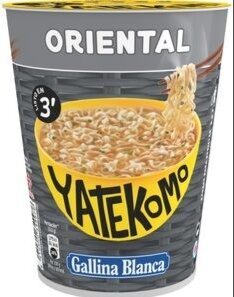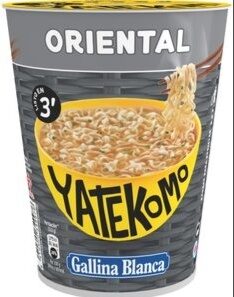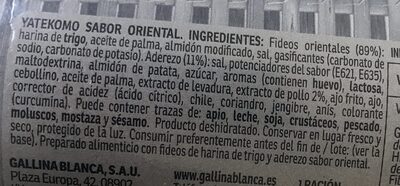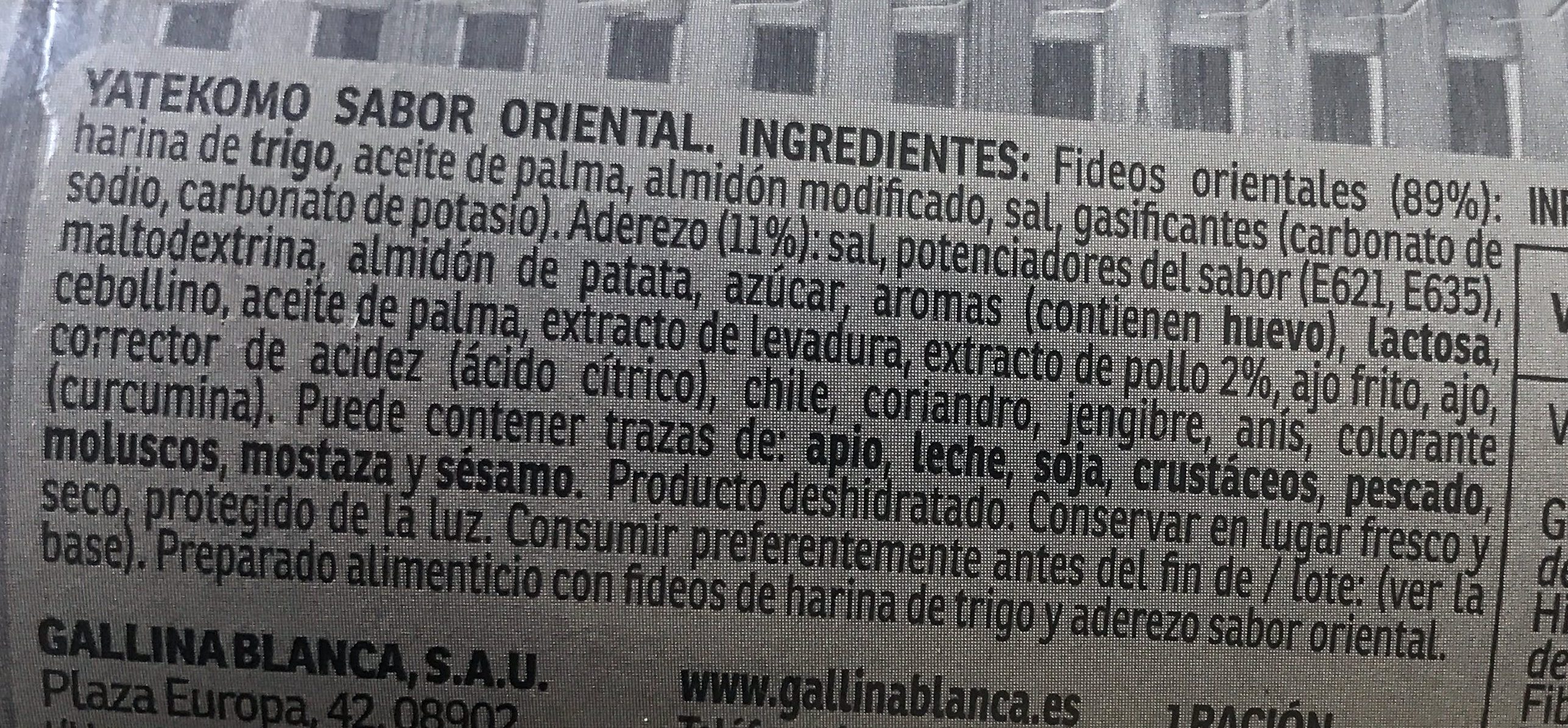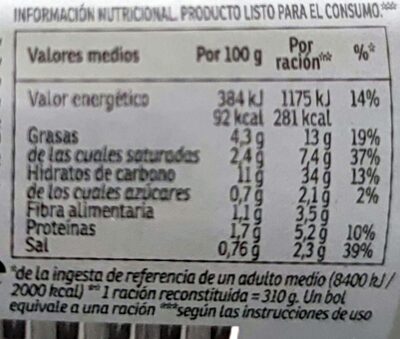Ajuda'ns a fer que la transparència alimentària sigui la norma!
Com a organització sense ànim de lucre, depenem de les vostres donacions per continuar informant els consumidors de tot el món sobre tot allò què mengen.
La revolució alimentària comença amb tu!
Yatekomo Oriental - Gallina Blanca - 61 g.
Yatekomo Oriental - Gallina Blanca - 61 g.
Aquesta pàgina del producte no està completa. Podeu ajudar a completar-la editant-la i afegint-hi més dades a partir de les fotos ja disponibles, o fent-ne més amb l'aplicació de androide o iPhone / iPad. Gràcies!
×
Codi de barres: 8410300349976 (EAN / EAN-13)
Nom comú: Preparado alimenticio con fideos de harina de trigo y aderezo sabor oriental
Quantitat: 61 g.
Empaquetament: Plàstic, en:Pot, es:Green dot
Marques: Gallina Blanca
Categories: Aliments i begudes amb base vegetal, Aliments amb base vegetal, Cereals i patates, Cereals i derivats, Menjar preparat, Productes secs, Pasta, Productes assecats per a ser rehidratats, Fideus, Sopes, en:Instant noodles, en:Chinese noodles
Etiquetes, certificacions, premis:
Punt verd
Enllaç a la pàgina del producte en el lloc oficial del productor: https://www.gallinablanca.es/producto/ya...
Botigues: Mercadona
Matching with your preferences
Salut
Ingredients
-
33 ingredients
Castellà: Fideos orientales (89%): harina de TRIGO, aceite de palma, almidón modificado, sal, gasificantes (carbonato de sodio, carbonato de potasio). Aderezo (11%)(sal, potenciadores del sabor (E621, E635), maltodextrina, almidón de patata, azúcar, aromas (contienen HUEVO), LACTOSA, cebollino , aceite de palma, extracto de levadura, extracto de pollo (2,0%), ajo frito, ajo, corrector de la acidez (ácido cítrico), chile, coriandro, jengibre, anis, colorante (curcumina)). Puede contener trazas de SOJA, PESCADO, LECHE, CRUSTÁCEOS, APIO, MOLUSCOS, MOSTAZA, SÉSAMO.Al·lèrgens: en:Eggs, en:Gluten, en:MilkRastres: en:Celery, en:Crustaceans, en:Fish, en:Milk, en:Molluscs, en:Mustard, en:Sesame seeds, en:Soybeans
Processament d'aliments
-
Aliments ultra processats
Elements que indiquen que el producte està al grup 4 - Aliments i begudes ultraprocessats:
- Additiu: E100 - Curcumina
- Additiu: E14XX - Midó modificat
- Additiu: E621 - Glutamat de monosodi
- Additiu: E635 - 5'-ribonucleòtid de disodi
- Ingredient: Color
- Ingredient: Potenciador del gust
- Ingredient: Aromes
- Ingredient: Lactosa
- Ingredient: Maltodextrina
Els productes alimentaris es classifiquen en 4 grups segons el seu grau de processament:
- Aliments no processats o mínimament processats
- Ingredients culinaris processats
- Aliments processats
- Aliments ultra processats
La determinació del grup es fa en funció de la categoria del producte i dels ingredients que conté.
Additius
-
E330 - Acid citric
Citric acid: Citric acid is a weak organic acid that has the chemical formula C6H8O7. It occurs naturally in citrus fruits. In biochemistry, it is an intermediate in the citric acid cycle, which occurs in the metabolism of all aerobic organisms. More than a million tons of citric acid are manufactured every year. It is used widely as an acidifier, as a flavoring and chelating agent.A citrate is a derivative of citric acid; that is, the salts, esters, and the polyatomic anion found in solution. An example of the former, a salt is trisodium citrate; an ester is triethyl citrate. When part of a salt, the formula of the citrate ion is written as C6H5O3−7 or C3H5O-COO-3−3.Origen: Wikipedia (Anglès)
-
E500 - Carbonats de sodi
Sodium carbonate: Sodium carbonate, Na2CO3, -also known as washing soda, soda ash and soda crystals, and in the monohydrate form as crystal carbonate- is the water-soluble sodium salt of carbonic acid. It most commonly occurs as a crystalline decahydrate, which readily effloresces to form a white powder, the monohydrate. Pure sodium carbonate is a white, odorless powder that is hygroscopic -absorbs moisture from the air-. It has a strongly alkaline taste, and forms a moderately basic solution in water. Sodium carbonate is well known domestically for its everyday use as a water softener. Historically it was extracted from the ashes of plants growing in sodium-rich soils, such as vegetation from the Middle East, kelp from Scotland and seaweed from Spain. Because the ashes of these sodium-rich plants were noticeably different from ashes of timber -used to create potash-, they became known as "soda ash". It is synthetically produced in large quantities from salt -sodium chloride- and limestone by a method known as the Solvay process. The manufacture of glass is one of the most important uses of sodium carbonate. Sodium carbonate acts as a flux for silica, lowering the melting point of the mixture to something achievable without special materials. This "soda glass" is mildly water-soluble, so some calcium carbonate is added to the melt mixture to make the glass produced insoluble. This type of glass is known as soda lime glass: "soda" for the sodium carbonate and "lime" for the calcium carbonate. Soda lime glass has been the most common form of glass for centuries. Sodium carbonate is also used as a relatively strong base in various settings. For example, it is used as a pH regulator to maintain stable alkaline conditions necessary for the action of the majority of photographic film developing agents. It acts as an alkali because when dissolved in water, it dissociates into the weak acid: carbonic acid and the strong alkali: sodium hydroxide. This gives sodium carbonate in solution the ability to attack metals such as aluminium with the release of hydrogen gas.It is a common additive in swimming pools used to raise the pH which can be lowered by chlorine tablets and other additives which contain acids. In cooking, it is sometimes used in place of sodium hydroxide for lyeing, especially with German pretzels and lye rolls. These dishes are treated with a solution of an alkaline substance to change the pH of the surface of the food and improve browning. In taxidermy, sodium carbonate added to boiling water will remove flesh from the bones of animal carcasses for trophy mounting or educational display. In chemistry, it is often used as an electrolyte. Electrolytes are usually salt-based, and sodium carbonate acts as a very good conductor in the process of electrolysis. In addition, unlike chloride ions, which form chlorine gas, carbonate ions are not corrosive to the anodes. It is also used as a primary standard for acid-base titrations because it is solid and air-stable, making it easy to weigh accurately.Origen: Wikipedia (Anglès)
-
E500i - Carbonat de sodi
Sodium carbonate: Sodium carbonate, Na2CO3, -also known as washing soda, soda ash and soda crystals, and in the monohydrate form as crystal carbonate- is the water-soluble sodium salt of carbonic acid. It most commonly occurs as a crystalline decahydrate, which readily effloresces to form a white powder, the monohydrate. Pure sodium carbonate is a white, odorless powder that is hygroscopic -absorbs moisture from the air-. It has a strongly alkaline taste, and forms a moderately basic solution in water. Sodium carbonate is well known domestically for its everyday use as a water softener. Historically it was extracted from the ashes of plants growing in sodium-rich soils, such as vegetation from the Middle East, kelp from Scotland and seaweed from Spain. Because the ashes of these sodium-rich plants were noticeably different from ashes of timber -used to create potash-, they became known as "soda ash". It is synthetically produced in large quantities from salt -sodium chloride- and limestone by a method known as the Solvay process. The manufacture of glass is one of the most important uses of sodium carbonate. Sodium carbonate acts as a flux for silica, lowering the melting point of the mixture to something achievable without special materials. This "soda glass" is mildly water-soluble, so some calcium carbonate is added to the melt mixture to make the glass produced insoluble. This type of glass is known as soda lime glass: "soda" for the sodium carbonate and "lime" for the calcium carbonate. Soda lime glass has been the most common form of glass for centuries. Sodium carbonate is also used as a relatively strong base in various settings. For example, it is used as a pH regulator to maintain stable alkaline conditions necessary for the action of the majority of photographic film developing agents. It acts as an alkali because when dissolved in water, it dissociates into the weak acid: carbonic acid and the strong alkali: sodium hydroxide. This gives sodium carbonate in solution the ability to attack metals such as aluminium with the release of hydrogen gas.It is a common additive in swimming pools used to raise the pH which can be lowered by chlorine tablets and other additives which contain acids. In cooking, it is sometimes used in place of sodium hydroxide for lyeing, especially with German pretzels and lye rolls. These dishes are treated with a solution of an alkaline substance to change the pH of the surface of the food and improve browning. In taxidermy, sodium carbonate added to boiling water will remove flesh from the bones of animal carcasses for trophy mounting or educational display. In chemistry, it is often used as an electrolyte. Electrolytes are usually salt-based, and sodium carbonate acts as a very good conductor in the process of electrolysis. In addition, unlike chloride ions, which form chlorine gas, carbonate ions are not corrosive to the anodes. It is also used as a primary standard for acid-base titrations because it is solid and air-stable, making it easy to weigh accurately.Origen: Wikipedia (Anglès)
-
E501 - Carbonats de potassi
Potassium carbonate: Potassium carbonate -K2CO3- is a white salt, which is soluble in water -insoluble in ethanol- and forms a strongly alkaline solution. It can be made as the product of potassium hydroxide's absorbent reaction with carbon dioxide. It is deliquescent, often appearing a damp or wet solid. Potassium carbonate is used in the production of soap and glass.Origen: Wikipedia (Anglès)
-
E501i - Carbonat de potassi
Potassium carbonate: Potassium carbonate -K2CO3- is a white salt, which is soluble in water -insoluble in ethanol- and forms a strongly alkaline solution. It can be made as the product of potassium hydroxide's absorbent reaction with carbon dioxide. It is deliquescent, often appearing a damp or wet solid. Potassium carbonate is used in the production of soap and glass.Origen: Wikipedia (Anglès)
-
E621 - Glutamat de monosodi
Monosodium glutamate: Monosodium glutamate -MSG, also known as sodium glutamate- is the sodium salt of glutamic acid, one of the most abundant naturally occurring non-essential amino acids. Glutamic acid is found naturally in tomatoes, grapes, cheese, mushrooms and other foods.MSG is used in the food industry as a flavor enhancer with an umami taste that intensifies the meaty, savory flavor of food, as naturally occurring glutamate does in foods such as stews and meat soups. It was first prepared in 1908 by Japanese biochemist Kikunae Ikeda, who was trying to isolate and duplicate the savory taste of kombu, an edible seaweed used as a base for many Japanese soups. MSG as a flavor enhancer balances, blends, and rounds the perception of other tastes.The U.S. Food and Drug Administration has given MSG its generally recognized as safe -GRAS- designation. A popular belief is that large doses of MSG can cause headaches and other feelings of discomfort, known as "Chinese restaurant syndrome," but double-blind tests fail to find evidence of such a reaction. The European Union classifies it as a food additive permitted in certain foods and subject to quantitative limits. MSG has the HS code 29224220 and the E number E621.Origen: Wikipedia (Anglès)
Anàlisi dels ingredients
-
Oli de palma
Ingredients que contenen oli de palma: Oli de palma, Oli de palma
-
No és vegà
Ingredients no vegans: Lactosa, PollastreAlguns ingredients no s'han pogut reconèixer.
Necessitem la teva ajuda!
Podeu ajudar-nos a reconèixer més ingredients i analitzar millor la llista d'ingredients d'aquest producte i d'altres mitjançant:
- Editeu aquesta pàgina de producte per corregir les faltes d’ortografia de la llista d’ingredients i/o per eliminar els ingredients d’altres idiomes i frases que no estiguin relacionades amb els ingredients.
- Afegiu entrades, sinònims o traduccions noves a les nostres llistes multilingües d’ingredients, mètodes de processament d’ingredients i etiquetes.
Uniu-vos al canal #ingredients del nostre espai de discussió a Slack i/o apreneu sobre l'anàlisi dels ingredients en la nostra wiki, si voleu ajudar. Gràcies!
-
No és vegetarià
Ingredients no vegetarians: PollastreAlguns ingredients no s'han pogut reconèixer.
Necessitem la teva ajuda!
Podeu ajudar-nos a reconèixer més ingredients i analitzar millor la llista d'ingredients d'aquest producte i d'altres mitjançant:
- Editeu aquesta pàgina de producte per corregir les faltes d’ortografia de la llista d’ingredients i/o per eliminar els ingredients d’altres idiomes i frases que no estiguin relacionades amb els ingredients.
- Afegiu entrades, sinònims o traduccions noves a les nostres llistes multilingües d’ingredients, mètodes de processament d’ingredients i etiquetes.
Uniu-vos al canal #ingredients del nostre espai de discussió a Slack i/o apreneu sobre l'anàlisi dels ingredients en la nostra wiki, si voleu ajudar. Gràcies!
-
Detalls de l'anàlisi dels ingredients
Necessitem la teva ajuda!
Alguns ingredients no s'han pogut reconèixer.
Necessitem la teva ajuda!
Podeu ajudar-nos a reconèixer més ingredients i analitzar millor la llista d'ingredients d'aquest producte i d'altres mitjançant:
- Editeu aquesta pàgina de producte per corregir les faltes d’ortografia de la llista d’ingredients i/o per eliminar els ingredients d’altres idiomes i frases que no estiguin relacionades amb els ingredients.
- Afegiu entrades, sinònims o traduccions noves a les nostres llistes multilingües d’ingredients, mètodes de processament d’ingredients i etiquetes.
Uniu-vos al canal #ingredients del nostre espai de discussió a Slack i/o apreneu sobre l'anàlisi dels ingredients en la nostra wiki, si voleu ajudar. Gràcies!
es: Fideos orientales 89% (harina de TRIGO), aceite de palma, almidón modificado, sal, gasificantes (carbonato de sodio, carbonato de potasio), Aderezo 11% (sal, potenciadores del sabor (e621, e635), maltodextrina, almidón de patata, azúcar, aromas (contienen HUEVO), LACTOSA, cebollino, aceite de palma, extracto de levadura, pollo 2%, ajo, ajo, corrector de la acidez (ácido cítrico), chile, coriandro, jengibre, anis, colorante (curcumina))- Fideos orientales -> es:fideos-orientales - percent: 89
- harina de TRIGO -> en:wheat-flour - vegan: yes - vegetarian: yes - ciqual_proxy_food_code: 9410
- aceite de palma -> en:palm-oil - vegan: yes - vegetarian: yes - from_palm_oil: yes - ciqual_food_code: 16129
- almidón modificado -> en:modified-starch - vegan: yes - vegetarian: yes - ciqual_proxy_food_code: 9510
- sal -> en:salt - vegan: yes - vegetarian: yes - ciqual_food_code: 11058
- gasificantes -> en:raising-agent
- carbonato de sodio -> en:e500i - vegan: yes - vegetarian: yes
- carbonato de potasio -> en:e501i - vegan: yes - vegetarian: yes
- Aderezo -> es:aderezo - percent: 11
- sal -> en:salt - vegan: yes - vegetarian: yes - ciqual_food_code: 11058
- potenciadores del sabor -> en:flavour-enhancer
- e621 -> en:e621 - vegan: yes - vegetarian: yes
- e635 -> en:e635 - vegan: maybe - vegetarian: maybe
- maltodextrina -> en:maltodextrin - vegan: yes - vegetarian: yes
- almidón de patata -> en:potato-starch - vegan: yes - vegetarian: yes - ciqual_proxy_food_code: 9510
- azúcar -> en:sugar - vegan: yes - vegetarian: yes - ciqual_proxy_food_code: 31016
- aromas -> en:flavouring - vegan: maybe - vegetarian: maybe
- contienen HUEVO -> es:contienen-huevo
- LACTOSA -> en:lactose - vegan: no - vegetarian: yes
- cebollino -> en:chives - vegan: yes - vegetarian: yes - ciqual_food_code: 11003
- aceite de palma -> en:palm-oil - vegan: yes - vegetarian: yes - from_palm_oil: yes - ciqual_food_code: 16129
- extracto de levadura -> en:yeast-extract - vegan: yes - vegetarian: yes
- pollo -> en:chicken - vegan: no - vegetarian: no - percent: 2
- ajo -> en:garlic - vegan: yes - vegetarian: yes - ciqual_food_code: 11000
- ajo -> en:garlic - vegan: yes - vegetarian: yes - ciqual_food_code: 11000
- corrector de la acidez -> en:acidity-regulator
- ácido cítrico -> en:e330 - vegan: yes - vegetarian: yes
- chile -> en:chili-pepper - vegan: yes - vegetarian: yes - ciqual_food_code: 20151
- coriandro -> es:coriandro
- jengibre -> en:ginger - vegan: yes - vegetarian: yes - ciqual_food_code: 11074
- anis -> en:aniseed - vegan: yes - vegetarian: yes
- colorante -> en:colour
- curcumina -> en:e100 - vegan: yes - vegetarian: yes
Nutrició
-
Qualitat nutricional mitjana
⚠ ️Atenció: no s'ha especificat la quantitat de fruites, verdures i fruits secs, no es té en compte la seva possible contribució positiva en la qualificació.Aquest producte no es considera una beguda per al càlcul de la Nutri-Score.
Punts positius: 2
- Proteïnes: 1 / 5 (valor: 1.7, valor arrodonit: 1.7)
- Fibra: 1 / 5 (valor: 1.1, valor arrodonit: 1.1)
- Fruites, verdures, fruits secs i olis de colza/nou/oliva: 0 / 5 (valor: 0, valor arrodonit: 0)
Punts negatius: 6
- Energia: 1 / 10 (valor: 384, valor arrodonit: 384)
- Sucres: 0 / 10 (valor: 0.7, valor arrodonit: 0.7)
- Greixos saturats: 2 / 10 (valor: 2.4, valor arrodonit: 2.4)
- Sodi: 3 / 10 (valor: 304, valor arrodonit: 304)
Els punts per proteïnes es compten perquè els punts negatius són inferiors a 11.
Puntuació nutricional: (6 - 2)
Nutri-Score:
-
Nivells de nutrients
-
Greix en Quantitat moderada (4.3%)
Què us cal saber- Un alt consum de greixos, especialment de greixos saturats, pot augmentar el colesterol, que augmenta el risc de patir malalties del cor.
Recomanació: Reduïu el consum de greixos i greixos saturats- Trieu productes amb menys greixos i greixos saturats.
-
Àcid gras saturat en Quantitat moderada (2.4%)
Què us cal saber- Un alt consum de greixos, especialment de greixos saturats, pot augmentar el colesterol, que augmenta el risc de patir malalties del cor.
Recomanació: Reduïu el consum de greixos i greixos saturats- Trieu productes amb menys greixos i greixos saturats.
-
Sucre en baixa quantitat (0.7%)
Què us cal saber- Un alt consum de sucre pot provocar augment de pes i càries dental. També augmenta el risc de patir diabetis tipus 2 i malalties cardiovasculars.
Recomanació: Limitau el consum de sucre i de begudes ensucrades- Les begudes ensucrades (com ara refrescos, begudes de fruites i sucs i nèctars de fruites) s'han de limitar tant com sigui possible (no més d'1 got al dia).
- Triau productes amb menor contingut de sucre i reduïu el consum de productes amb sucres afegits.
-
Sal comuna en Quantitat moderada (0.76%)
Què us cal saber- Un alt consum de sal (o sodi) pot provocar un augment de la pressió arterial, que pot augmentar el risc de patir malalties del cor i ictus.
- Moltes persones que tenen hipertensió no ho saben, ja que sovint no en tenen símptomes.
- La majoria de la gent consumeix massa sal (de 9 a 12 grams de mitjana al dia), al voltant del doble del nivell màxim d'ingesta recomanat.
Recomanació: Limitau la ingesta de sal i d'aliments rics en sal- Reduïu la sal que emprau quan cuinau, i no afegiu sal a taula.
- Limiteu el consum d'aperitius salats i trieu productes amb menor contingut de sal.
-
-
Informació nutricional
Informació nutricional Com es ven
per 100 g/100 mlPreparat
per 100 g/100 mlPreparat
per porció (310 g)Comparat amb: en:Chinese noodles Energia ? 384 kj
(92 kcal)1.190 kj
(285 kcal)Greix ? 4,3 g 13,3 g Àcid gras saturat ? 2,4 g 7,44 g Hidrats de carboni ? 11 g 34,1 g Sucre ? 0,7 g 2,17 g Fiber ? 1,1 g 3,41 g Proteïna ? 1,7 g 5,27 g Sal comuna ? 0,76 g 2,36 g Fruits‚ vegetables‚ nuts and rapeseed‚ walnut and olive oils (estimate from ingredients list analysis) 0,003 % ? ?
Entorn
-
Eco-puntuació C - Impacte ambiental moderat
El Eco-Score és una puntuació experimental que resumeix els impactes ambientals dels productes alimentaris.→ L'Eco-Score es va desenvolupar inicialment a França i s'està ampliant per a altres països europeus. La fórmula Eco-Score està subjecta a canvis, ja que es millora periòdicament per fer-la més precisa i més adequada per a cada país.Anàlisi del cicle de vida
-
Impacte mitjà dels productes de la mateixa categoria: A (Score: 82/100)
Categoria: Asian noodles, flavoured, dehydrated
Categoria: Asian noodles, flavoured, dehydrated
- Puntuació ambiental PEF ( petjada ambiental de l'aliment ): 0.26 (com més baixa sigui la puntuació, menor serà l'impacte)
- incloent l'impacte sobre el canvi climàtic: 1.67 kg CO₂ eq/kg del producte
Etapa Impacte Agricultura
65.5 %Processament
20.6 %Empaquetament
8.7 %Transport
3.5 %Distribució
1.8 %Consum
0.0 %
Bonificacions i punts negatius
-
Falta informació sobre l'origen dels ingredients
Punts negatius: -5
⚠ ️ L'origen dels ingredients d'aquest producte no està indicat.
Si estan indicats a l'embalatge, podeu modificar la fitxa del producte i afegir-los.
Si sou el fabricant d'aquest producte, podeu enviar-nos la informació amb la nostra plataforma gratuïta per a productors.
-
Ingredients que amenacen les espècies
Punts negatius: -10
Conté oli de palma
Els boscos tropicals d'Àsia, Àfrica i Amèrica Llatina es destrueixen per crear i ampliar les plantacions de palmera d'oli. La desforestació contribueix al canvi climàtic, i posa en perill espècies com l'orangutan, l'elefant pigmeu i el rinoceront de Sumatra.
-
Embalatge d'impacte mitjà
Punts negatius: -10
Forma Material Reciclatge Impacte Pot Plàstic Alt
Eco-Score per a aquest producte
-
Impacte per a aquest producte: C (Score: 57/100)
Producte: Yatekomo Oriental - Gallina Blanca - 61 g.
Puntuació de l'anàlisi del cicle de vida: 82
Suma de bonificacions i punts negatius: -25
Puntuació final: 57/100
-
Petjada de carboni
-
Equivalent a conduir 0.9 km en un cotxe de gasolina
167 g de CO² per cada 100 g de producte
La xifra d'emissions de carboni prové de la base de dades Agribalyse d'ADEME, per a la categoria: Asian noodles, flavoured, dehydrated (Font: Base de dades ADEME Agribalyse)
Etapa Impacte Agricultura
61.0 %Processament
14.9 %Empaquetament
16.3 %Transport
6.8 %Distribució
1.0 %Consum
0.0 %
Empaquetament
-
Embalatge d'impacte mitjà
-
Peces d'embalatge
Pot (Plàstic)
-
Materials d'embalatge
Material % Pes de l'embalatge Pes de l'embalatge per 100 g de producte Plàstic
-
Transport
-
Orígens dels ingredients
Falta informació sobre l'origen dels ingredients
⚠ ️ L'origen dels ingredients d'aquest producte no està indicat.
Si estan indicats a l'embalatge, podeu modificar la fitxa del producte i afegir-los.
Si sou el fabricant d'aquest producte, podeu enviar-nos la informació amb la nostra plataforma gratuïta per a productors.Add the origins of ingredients for this product Add the origins of ingredients for this product
Espècies amenaçades
-
Conté oli de palma
Fomenta la desforestació i amenaça espècies com l'orangutan
Els boscos tropicals d'Àsia, Àfrica i Amèrica Llatina es destrueixen per crear i ampliar les plantacions de palmera d'oli. La desforestació contribueix al canvi climàtic, i posa en perill espècies com l'orangutan, l'elefant pigmeu i el rinoceront de Sumatra.
Report a problem
-
Incomplete or incorrect information?
Category, labels, ingredients, allergens, nutritional information, photos etc.
If the information does not match the information on the packaging, please complete or correct it. Open Food Facts is a collaborative database, and every contribution is useful for all.
Fonts de dades
Producte afegit per kiliweb
Última modificació de la pàgina del producte per redspider.
La pàgina del producte, també editada per alia, balance2014, bertrand-a, covol44, elcoco, foodless, openfoodfacts-contributors, packbot, saisa, thaialagata, yuka.DJVDOMyFO-8PR9zwj4VowAK1O-rNWvpzMi4Oog, yuka.VExBa0FJZFlwZWNSd2NZdjd4M2MrWXQrMThlcURINitDTzlNSVE9PQ, yuka.WEpBa0svd3h0c3N4aHNjVDJEaUkwUDUrd0o2c0FrQ3lNY0F0SVE9PQ, yuka.YVlRWlBZWVR0T0F4dXRzWDF5N0Y5WXRid0srclVYSzZkN1FlSWc9PQ, yuka.ZHJwUkxKNGZvdmdGb3RnMC8wekw0L1o2eFppMEExT1FjK3M5SUE9PQ, yuka.sY2b0xO6T85zoF3NwEKvlhNiYtDMpzObZ0bunVG0_97XEJj4eY5i6aLmP6s, yuka.sY2b0xO6T85zoF3NwEKvlmhcXtOAhizAHR_6lnGWwd2sCKHEbeBWzdimHqs, zaran64.
